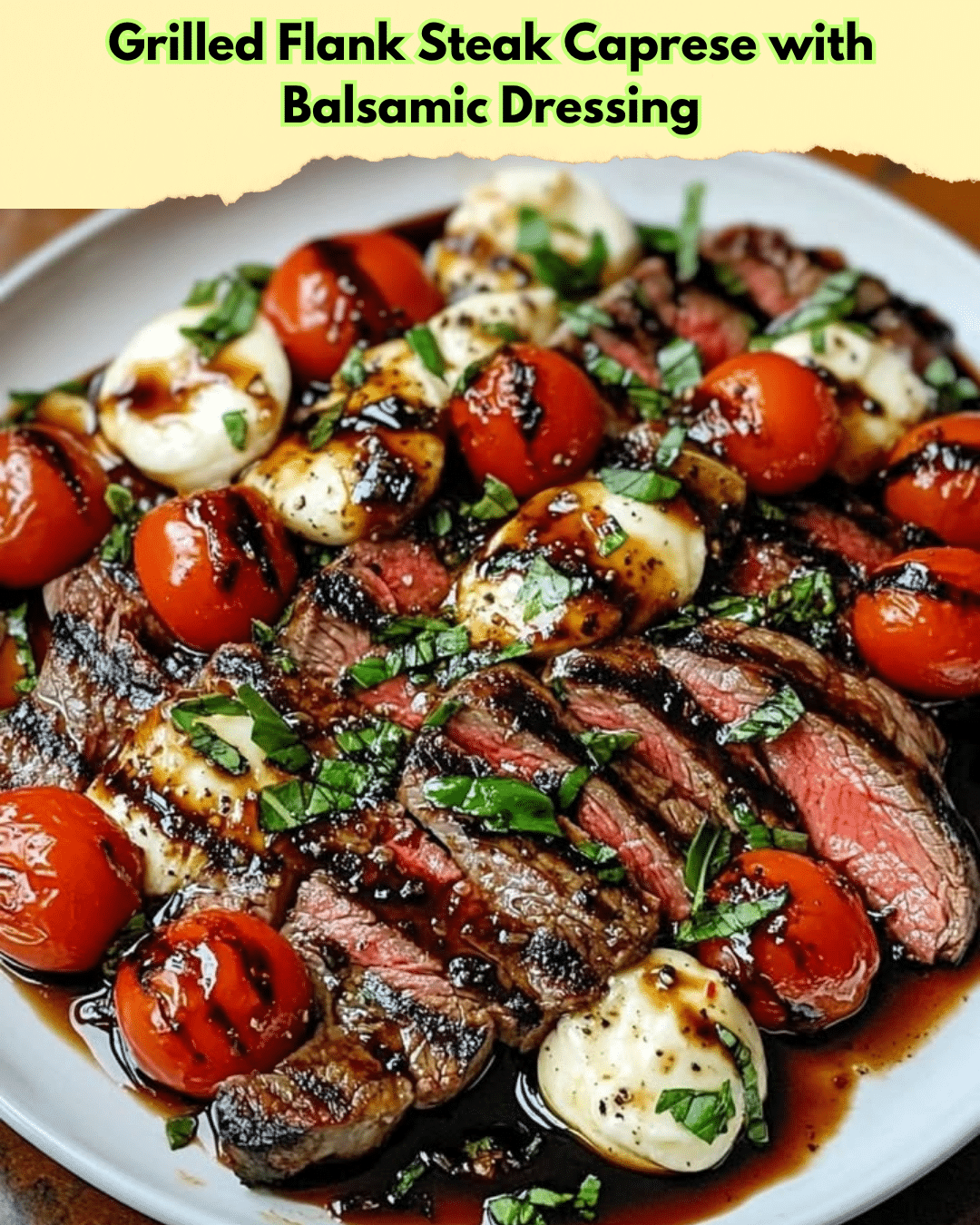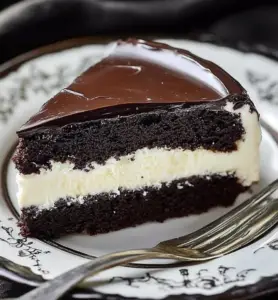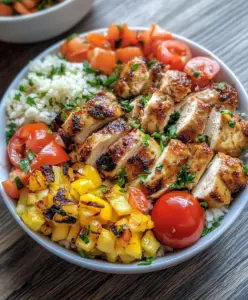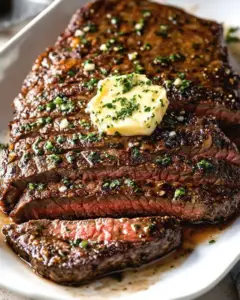Grilled Flank Steak Caprese with Balsamic Dressing: A Delightful Culinary Experience
Experience a perfect blend of savory and fresh flavors with this Grilled Flank Steak Caprese with Balsamic Dressing. The grilled flank steak, with its robust juiciness, is beautifully complemented by the fresh caprese salad elements. Combined with a tangy balsamic dressing, this dish promises a heavenly dining experience. Whether you are hosting a summer cookout or looking for a quick yet elegant meal, this recipe will surely impress.
Celebrate your love for steak and Italian cuisine with this delightful Grilled Flank Steak Caprese with Balsamic Dressing. With its rich aroma and vibrant flavors, the dish captures the essence of traditional Caprese salad while adding the satisfying depth of grilled beef. You’ll enjoy the balance of succulent meat with creamy mozzarella, juicy tomatoes, and fragrant basil, all highlighted by the sweet and zesty balsamic reduction.
Quick Recipe Highlights
Flavor Profile: This dish brings together bold, hearty flavors from the grilled steak with the fresh, tangy, and creamy elements of caprese salad, elevated by a sweet balsamic dressing.
Texture: The dish offers a delightful interplay of textures, from the tender and juicy steak to the soft mozzarella and the crisp fresh basil leaves.
Aroma: The enticing aroma of grilled steak melds with fresh basil and the subtly sweet scent of balsamic vinegar, creating an inviting atmosphere.
Visual Appeal: Visually stunning, the rich browns of the grill marks contrast with the bright reds and whites of the caprese salad, garnished elegantly with green basil.
Skill Level Needed: This recipe requires basic grilling skills and a good understanding of timing and seasoning to bring out the perfect balance of flavors.
Special Equipment: A grill for the steak is necessary, along with a sharp knife for slicing, and a small saucepan to prepare the balsamic reduction.
Recipe Overview
Difficulty Level: This recipe is moderately challenging, requiring some skill to perfectly grill the steak and prepare the reduction without overcooking it. It demands attention to detail for slicing and arranging caprese ingredients beautifully.
Category: This dish falls under main courses, integrating elements of both protein-rich meals and lighter salads, making it a versatile option for various dining settings.
Cuisine: While rooted in Italian traditions through the caprese salad, the grilled steak presents an American twist, highlighting a cross-cultural culinary exploration.
Cost: The cost is moderate, mainly influenced by the quality of the flank steak and mozzarella cheese, but overall it provides an affordable gourmet experience.
Season: Ideal for spring and summer when fresh basil and tomatoes are at their peak and grilling outdoors is inviting and enjoyable.
Occasion: Perfect for dinner parties, family gatherings, and cookouts, providing a dish that satisfies both steak lovers and those inclined to lighter fare.
Why You’ll Love This Recipe
Taste and texture appeal: Grilled Flank Steak Caprese with Balsamic Dressing offers a delicate balance of flavors and textures that will captivate your taste buds. The steak is savory and juicy, complemented perfectly by the creamy mozzarella and the characteristic sweet and tangy notes of balsamic. The dish combines soft, crunchy, and juicy textures, ensuring each bite is an experience.
Convenience and preparation benefits: This recipe is quick to prepare, making it perfect for both weeknight dinners and special occasions. With minimal prep time and straightforward grilling, you’ll swiftly create a gourmet dish without the fuss of complex instructions, making it perfect for anyone with a busy schedule but a love for fine dining.
Nutritional advantages: This dish incorporates key nutrients, offering a nourishing balance of protein from the steak, healthy fats from the cheese and olive oil, and a dose of vitamins from the tomatoes and basil, contributing to a well-rounded and delicious meal without excessive calories.
Social and entertaining value: Its visual appeal and sophisticated taste make it an excellent centerpiece for gathering, inviting lively discussions over taste and presentation. Whether for a date night or a gathering of friends, this dish enhances the dining experience with its charm and taste.
Cost-effectiveness and accessibility: Despite its delicious and intricate flavors, the recipe is budget-friendly, allowing you to create an impressive dish without breaking the bank. Ingredients are easy to find at local grocery stores, ensuring you can bring this culinary delight from kitchen to table effortlessly.
Historical Background and Cultural Significance
The origin of the Grilled Flank Steak Caprese with Balsamic Dressing can be traced back to Italy’s rich culinary heritage, where the Caprese salad originated on the island of Capri. This simple salad of mozzarella, tomatoes, and basil reflects the colors of the Italian flag and celebrates the island’s fresh produce.
Culturally, the Caprese salad is cherished in Italy for its simplicity and is symbolic of the Mediterranean diet. The addition of grilled flank steak adapts it to incorporate global influences, reflecting the evolution of culinary traditions as cultures blend and culinary borders blur.
Over time, this dish has evolved to include variations that incorporate different types of cheese, meats, and dressings, adapting to regional ingredient availability. The balsamic dressing adds an element hailing from Modena in Italy, famous for its high-quality balsamic vinegar, enhancing the dish’s authenticity.
Regional variations of this dish might involve substituting the steak with chicken or fish, reflecting the versatility of the Caprese ingredients. The dish thus remains a popular choice across various countries, loved for its adaptability and delicious flavor profile.
Ingredient Deep Dive
Flank Steak is the star of the dish, providing a robust umami flavor profile that pairs beautifully with the other ingredients. It is essential in many cultures as a less tender yet flavorful cut, appreciated for its rich taste and affordability compared to other cuts.
Flank steak is a good source of lean protein and important micronutrients such as iron and zinc, contributing to muscle repair and general health. When selecting flank steak, look for deep red color and visible marbling to ensure tenderness and flavor after cooking. Store wrapped tightly in parchment paper in a refrigerator for a few days or freeze it for longer storage.
Mozzarella adds creaminess and pairs well with the steak and tomatoes. It’s a staple in Italian dishes and revered for its texture and mild flavor profile, enhancing salads and hot entrees alike with its melty, stretchable consistency.
Choose fresh mozzarella for its softer, more delicate texture and mild flavor, perfect for salads. Mozzarella contains valuable nutrients like calcium and protein. It should be stored in water in an airtight container in the fridge. If unavailable, burrata or feta cheese can be used as a substitute, providing additional richness.
Common Mistakes to Avoid
Not allowing the steak to come to room temperature before grilling, which can cause uneven cooking. Make sure to let your steak sit out for about 30 minutes before grilling.
Overcooking the steak can result in a tough texture. Aim for a medium-rare doneness for the best flavor and texture. Use a meat thermometer to ensure accuracy.
Skimping on the balsamic reduction, which adds a pleasant sweetness and depth to the dish. Reduce it until it’s thickened to coat the back of a spoon for optimal flavor.
Ignoring the quality of mozzarella cheese can lead to an unbalanced dish as it complements the steak’s savoriness. Opt for quality buffalo mozzarella for a better taste.
Slicing the flank steak incorrectly can detract from tenderness. Slice against the grain in thin strips to enhance mouthfeel and presentation.
Neglecting to add salt to the tomatoes can result in a flat taste profile. Lightly salt them to bring out their natural sweetness and balance flavors.
Overdressing the salad can drown out the individual flavors. Use the balsamic dressing sparingly, adding more as needed.
Failing to rest the steak after grilling can lead to dryness due to juices lost. Allow it to rest at least 5 minutes before slicing to retain moisture.
Essential Techniques
Grilling the steak perfectly is crucial for flavor and texture. Achieving perfect doneness involves controlling the grill temperature and timing. Aim for high heat to sear the steak, locking in juices and flavor.
Properly seasoning components separately ensures each element of the dish shines with balanced flavors. Season the steak before grilling and the caprese ingredients before assembling.
Mastering the balsamic reduction will bring depth and sweetness to the dish. Cook it slowly over medium heat until it’s thick enough to coat the back of a spoon, enhancing the overall flavor composition.
Slicing the steak against the grain ensures maximum tenderness. Observe the lines running across the surface of the meat and make perpendicular cuts.
Balancing flavors involves utilizing all taste profiles: sweet, savory, and tangy, helping to create a balanced and palatable dish.
Pro Tips for Perfect Grilled Flank Steak Caprese
Use a meat thermometer to ensure the steak is cooked to your preferred doneness, aiming for 130°F for medium-rare.
Resting the steak before slicing allows the juices to redistribute, ensuring juicy and tender bites. Cover it loosely with foil and let rest for about 5-10 minutes.
Choose high-quality olive oil for dressing the caprese salad. It makes a noticeable difference in flavor, enriching the dish’s simplicity with luxurious mouthfeel.
Plating the salad immediately before serving keeps the ingredients fresh and vibrant. Prepare everything in advance and assemble just prior to serving for the best results.
Experiment with ripe heirloom tomatoes for a unique flavor profile and enhanced visual aesthetics. Their colorful flesh and varied flavors elevate the dish.
Substitute arugula or spinach for basil if unavailable or if you desire a different texture. Both greens add a peppery kick that balances the other flavors harmoniously.
Variations and Adaptations
Regional variations could see the flank steak replaced with other meats like chicken or pork, or even seafood, creating a different texture and flavor profile. Substitute with local cheeses such as feta for a refreshing change.
Seasonal adaptations allow freedom with vegetables. In winter, roast tomatoes first or introduce different produce for added richness.
Dietary modifications for vegan diners can replace mozzarella with plant-based cheeses, or omit steak entirely for a simple yet delicious caprese salad.
Flavor variations might involve adding spicy elements like crushed red pepper flakes or garlic cloves to the steak marinade for an aromatic kick.
Texture modifications such as longer marination for the steak can penetrate flavors more bitterly, making the meat more tender and enriching overall mouthfeel.
Presentation alternatives like stacking the caprese and steak akin to a tower can provide a modern twist and visually impactful display.
Serving and Presentation Guide
Arrange steak slices beautifully on the plate alongside the caprese for an impressive visual display. Drizzle the balsamic reduction artistically across the dish to enhance appeal.
Garnish with fresh basil leaves to enhance color and aroma. For a more sophisticated dish, add edible flowers like nasturtiums for an elegant touch.
Serve traditionally with a side of crusty bread to complement the meal, soaking up the delicious drizzles left behind.
For modern serving suggestions, consider serving on individual boards for guests, highlighting each dish’s freshness and individuality.
Temperature considerations involve grilling the steak just before meal time to serve it warm, contrasting the chilled salad’s freshness.
Portion control tips suggest allowing about 4-6 ounces of steak per serving, balancing protein needs with other accompanying foods for a satisfying meal.
Wine and Beverage Pairing
Pair with a light-bodied red wine such as a Pinot Noir. Its fruitiness and slight acidity harmonize beautifully with the sweet balsamic and juicy steak.
For non-alcoholic alternatives, consider serving a fruity iced tea or pomegranate juice as their tartness balances the dish’s sweet and savory elements.
If applicable, opt for a medium-bodied coffee or an herbal tea pairing that mirrors the vibrant notes of the dish, enhancing aftertaste with subtle aromatics.
Consider serving at a mild chill for a refreshing impact, especially when paired with this hearty yet fresh dish.
Present wine in elegant glassware, enhancing the sharing experience and drawing focus to dining elements that elevate dinner conversations.
Storage and Shelf Life
Store leftover steak in an airtight container once cooled completely to prevent drying out and maintain freshness.
Maintain a refrigerator temperature of 40°F to preserve flavors without compromising the steak’s tenderness.
Containers made of glass or BPA-free plastic should be used for their non-reactive properties and easy transportability.
Signs of spoilage like an off smell or slimy texture should alert you to discard the steak and salad elements.
For reheating, a gentle warm-up in a skillet over low heat is recommended to retain moisture and avoid toughness.
Freezing guidelines suggest pre-slicing the steak and storing it with parchment paper between layers, safeguarding against freezer burn while easing portioned reheating.
Make Ahead Strategies
Starting with prep timeline, ingredients can be readied a day ahead by marinating the steak and preparing the balsamic reduction.
Store elements like balsamic reduction separately in the fridge and assemble the entire dish just before serving to ensure freshness.
The quality impact by keeping elements separated until serving retains desired characteristics like crispness and juice content.
Assemble the dish moments before dining to prevent sogginess and flavor melding, maintaining integrity of distinct, vibrant flavors.
Warm up the steak briefly before combining with caprese elements to restore succulence while integrating freshly prepared components.
Fresh element additions like tearing basil leaves just at serving reinforce aromatic freshness that defines the caprese character.
Scaling Instructions
When halving the recipe, halve all ingredients in proportion to avoid overpowering any particular flavor element, maintaining balance.
Doubling or tripling the recipe is straightforward due to simple ingredient list and cooking methods, taking care to keep ingredient proportions aligned.
Adjustments in equipment might require accommodating larger volumes using larger pans for browning or more skillets for efficient grill space usage.
Time considerations when scaling involve grilling in batches to prevent overcrowding, ensuring even cooking and optimal flavor development.
Storage considerations expand with larger recipes, ensuring ample fridge space with enough airtight containers to accommodate increased yield without spoilage risk.
Nutritional Deep Dive
With a macro breakdown, this dish offers a well-rounded meal focusing on protein from the steak plus healthy fats found in mozzarella cheese and olive oil.
A micronutrient analysis reveals benefits from tomatoes and basil, which contribute vitamin C and antioxidants supporting overall immune health.
Health advantages extend from lean protein supporting muscle repair to basil’s anti-inflammatory properties adding subtle wellness benefits.
Consider dietary guidelines by adopting portion awareness for balanced calorie intake, mindful of nutritional needs aligning with family or guests’ health goals.
Portion analysis of steak against lighter caprese aids healthy choices, keeping caloric intake consistent with daily dietary requirements.
Weight management tips include mindful eating, supporting healthy lifestyles associating enjoyment in dining with balance and moderation.
Dietary Adaptations
For gluten-free needs, ensure the balsamic dressing’s source is certified gluten-free, upholding dietary integrity safely.
Dairy-free adaptation can be achieved through substituting fresh mozzarella with plant-based alternatives like almond or cashew cheeses.
For a vegan twist, beyond excluding steak, leverage marinated tofu slices or grilled portobello mushrooms to retain umami satisfaction.
Low-carb diets can adapt by reducing or eliminating balsamic vinegar’s sweet component, preserving savory flavors instead.
Keto dietary considerations advise limiting carbs by substituting balsamic with a cream-based sauce, enriching fat content consistent with guidelines.
Paleo dietary modification simplifies core ingredients, focusing on fresh, unprocessed elements free from preservatives.
Low-FODMAP needs might eliminate or substitute garlic and onion components while retaining satisfying flavors.
For other specific diets, accommodating individual ingredients that fit within dietary restrictions remains key, empowering inclusive dining experiences.
Troubleshooting Guide
Addressing texture issues, ensuring the flank steak rests sufficiently before slicing prevents dryness and tough chew, enhancing tenderness.
For balancing flavors, adjusting balsamic reduction consistency enhances sweetness alignment, avoiding cloying tones that overshadow delicate profiles.
Temperature problems of overcooked steaks resolve when utilizing thermometers, achieving precise medium-rare results consistently.
Equipment challenges evolve when understanding grill dynamics, achieving optimal sear with varying setups ensuring even browning.
Substituting key ingredients involves maintaining harmony carefully. Flavor profile shifts guide substitutions avoiding ingredient clash.
Timing concerns avoid rush cooking; speed compromises achieving balance. Prioritize adequate preparation, fostering seamless event readiness.
Recipe Success Stories
Community feedback highlights success with creative adaptations, ethnic enhancements, and innovative serving approaches delighting all palates.
Variation successes showcase adaptability across cultures and seasons, responding to tastes from spice infusion to additional cheese layers.
Adaptation stories reflect personal touches like herb integration emphasizing complementary flavors, fostering inventive culinary expression.
Reader suggestions inspire presentation evolutions, experimenting with tower stacking, spiral arrangements, or mixed platters magnifying aesthetics.
Photography tips pertaining to natural light, angled shots capturing depth, and incorporating vibrant garnishes add dimension showcasing nuanced appeal.
Frequently Asked Questions
How long should I grill flank steak to achieve medium-rare doneness? Grill approximately 4-5 minutes per side on high heat. Use a thermometer to confirm 130°F internal temperature.
What if I don’t have a grill? A cast-iron skillet is an excellent alternative, providing high-temperature searing to achieve a similar crust and juicy interior.
Can I prepare elements ahead of time to save time on the event day? Yes, you can marinate the steak and prepare the balsamic reduction the night before for an effortless assembly during the event.
What wines pair well with this dish? Light to medium-bodied reds, such as Pinot Noir or Chianti, complement the dish’s elements gracefully.
What are alternative protein options for vegetarians? Grilled mushrooms or marinated tofu offers substantial flavor bases without sacrificing protein or satisfaction.
Can I freeze leftovers successfully? Yes, wrap tightly to prevent freezer burn, dividing portions between parchment layers, and reheat gently to maintain flavor.
Is fresh basil optional, or is there a substitute? Fresh basil enhances the classic caprese profile, but arugula or fresh parsley imparts delightful replacements.
Are substitutions possible with balsamic reduction? Non-reduced balsamic vinegar mixed with honey provides sweetness, mimicking reduction, albeit thinner.
Can children enjoy this dish? Adjust balsamic quantity and seasoning to cater to their tastes, ensuring non-spicy components are child-friendly.
What options exist for serving at a larger event? Prepare principal components in bulk, carving steak tableside, inspiring joyful connection with personalized servings.
Additional Resources
Explore our collection of related recipes with heroic flavors like Grilled Chicken Caprese or Vegan Portobello Mushroom Caprese for more delightful ideas.
Technique guides exploring flawless steak grilling or mastering balsamic reductions illuminate nuanced culinary capabilities elevating everyday dishes.
Delve into ingredient information detailing fresh mozzarella’s versatility and utilization in global cuisines, revealing interconnected culinary applications.
Equipment recommendations demonstrate introductory grill insights and cast-iron alternatives, serving ingenious choices informing purchase decisions.
Examine seasonal variations integrating adapted Caprese themes, adapting ingredients through produce cycles, offering rich vibrant character year-round.
Print
Grilled Flank Steak Caprese with Balsamic Dressing
Description
A savory grilled flank steak paired with a fresh Caprese salad and drizzled with a rich balsamic dressing.
Ingredients
For the Crust:
- 1.5 lbs flank steak
- 2 cups cherry tomatoes, halved
- 8 oz fresh mozzarella, sliced
- 1/4 cup fresh basil leaves
- 1/4 cup balsamic vinegar
- 3 tablespoons olive oil
- Salt and pepper to taste
Instructions
1. Prepare the Crust:
- Season the flank steak with salt and pepper, then grill over medium-high heat for 6-8 minutes per side or until desired doneness. Let it rest before slicing.
- In a bowl, combine cherry tomatoes, mozzarella slices, and basil leaves. Toss gently with olive oil and a pinch of salt.
- In a small saucepan, reduce balsamic vinegar over medium heat until thickened to a syrupy consistency, about 5 minutes.
- Arrange sliced steak on a platter, top with the tomato and mozzarella mixture, and drizzle with the balsamic reduction before serving.
Notes
You can customize the seasonings to taste.




